An XML sitemap acts like a roadmap for search engines, guiding them to all the important pages and content on your website. This helps them discover and index your content more efficiently, ensuring your website’s visibility in search results.
On WPBeginner, we use All in One SEO to automatically generate XML sitemaps and give us extra control, such as the ability to exclude certain taxonomies. However, we researched other ways to create WordPress sitemaps so you can choose the method that best suits your website.
In this article, we will explain what an XML sitemap is and how you can easily create a sitemap in WordPress. We will cover how to do this with and without a plugin and show you how to submit your sitemap to search engines so your website is indexed faster.
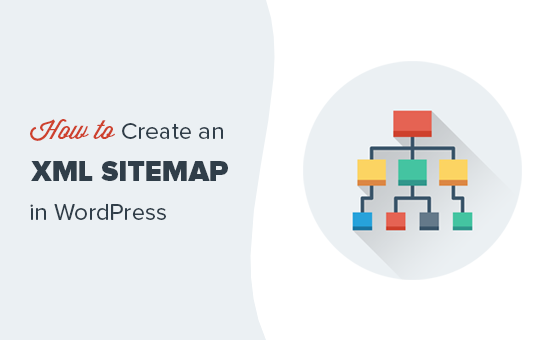
What Is an XML Sitemap?
An XML sitemap is a file that lists all your website content in an XML format so that search engines like Google can easily discover and index your content.
Back in the early 2000s, government websites used to have a link on their main pages titled ‘Sitemap’. This page usually contained a list of all the important pages on that website.
While some websites still have HTML sitemap pages today, the overall usage of sitemaps has evolved over the years.
Today sitemaps are published in an XML file format instead of HTML, and their target audience is search engines and not people.
Basically, an XML sitemap is a way for website owners to tell search engines about all the pages that exist on their website.
It also tells search engines which links are more important than others and how frequently you update your website.
While XML sitemaps will not boost your search engine rankings, they allow search engines to crawl your website better. This means they can find more content and start showing it in search results, thus resulting in more search traffic and improved SEO rankings.
Why You Need an XML Sitemap
Sitemaps are extremely important from a search engine optimization (SEO) point of view.
Simply adding a sitemap file will not affect your search rankings. However, if there is a page on your site that is not indexed, then a sitemap will let search engines know about that page.
Sitemaps are extremely useful when you first start a blog or create a new website because most new websites don’t have any backlinks. This makes it harder for search engines to discover all of your content.
This is why search engines like Google and Bing allow new website owners to submit a sitemap in their webmaster tools. This allows their search engine bots to easily discover and index your content (more on this later).
Sitemaps are equally important for established popular websites as well. They allow you to highlight which parts of your website are more important and which parts are more frequently updated so that search engines can index your content accordingly.
That being said, let’s take a look at how to create an XML sitemap in WordPress.
Video Tutorial
If you prefer written instructions, just keep reading.
There are several ways to create an XML sitemap in WordPress. We will show you three popular methods to create an XML sitemap in WordPress. We will also show you how to submit your sitemaps to search engines and use them to grow your site.
Method 1: Creating an XML Sitemap in WordPress Without a Plugin
This method is very basic and limited in terms of features.
Before August 2020, WordPress didn’t have built-in sitemaps. However, in WordPress 5.5, they released a basic XML sitemap feature.
This feature allows you to automatically create an XML sitemap in WordPress without using a plugin. You can simply add wp-sitemap.xml at the end of your domain name, like this:
https://www.example.com/wp-sitemap.xml
WordPress will show you the default XML sitemap.
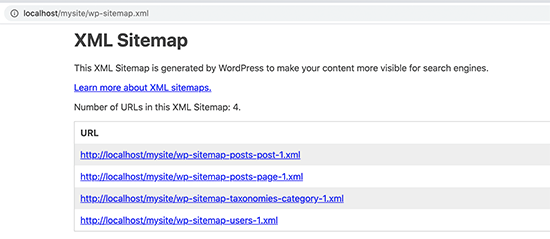
This XML sitemap feature was added to WordPress to make sure that any new WordPress website does not miss out on the SEO benefits of an XML sitemap.
However, it is not very flexible, and you cannot easily control what to add or remove from your XML sitemaps.
Luckily, almost all top WordPress SEO plugins come with their own sitemap functionality. These sitemaps are better, and you can control which content to remove or exclude from your WordPress XML sitemaps.
Method 2: Creating an XML Sitemap in WordPress Using AIOSEO
The easiest way to create an XML sitemap in WordPress is by using the All in One SEO (AIOSEO) plugin for WordPress.
It is the best WordPress SEO plugin on the market, offering you a sitemap generator and a comprehensive set of tools to optimize your blog posts for SEO.
First, you need to install and activate the All in One SEO plugin. For more details, see our step-by-step guide on how to install a WordPress plugin.
The sitemap feature is also available in AIOSEO Free version. However, to get advanced news sitemaps and video sitemaps, you will need the Pro version.
Upon activation, go to the All in One SEO » Sitemaps page to review the sitemap settings.
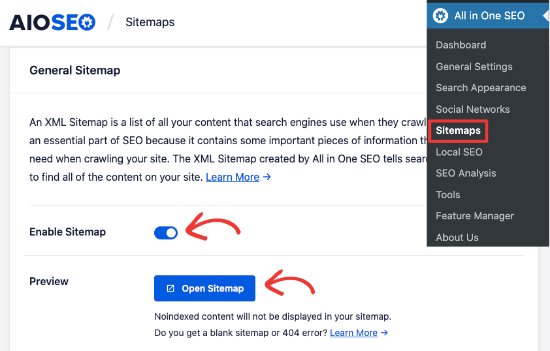
By default, All in One SEO will enable the Sitemap feature for you and replace the basic WordPress sitemaps.
You can click on the ‘Open Sitemap’ button to preview it to see what it looks like. You can also view your sitemap by adding sitemap.xml to your website’s URL, such as:
https://www.example.com/sitemap.xml

As a beginner, you don’t need to do anything, as the default settings will work for all kinds of websites, blogs, and online stores.
However, you can customize the sitemap settings to control what you want to include in your XML sitemap.
Simply scroll down to the ‘Sitemap Settings’ section.

This section gives you options to manage sitemap indexes and include or exclude post types and taxonomies (categories and tags). You can also enable XML sitemaps for date-based archives and author archives.
All in One SEO automatically includes all your WordPress content in XML sitemaps. But what if you have stand-alone pages like a contact form, a landing page, or Shopify store pages that are not part of WordPress?
Well, AIOSEO is the only plugin that lets you add external pages to your WordPress sitemap. Simply scroll to the ‘Additional Pages’ section and turn it on. This will show you a form where you can add any custom pages that you want to include.
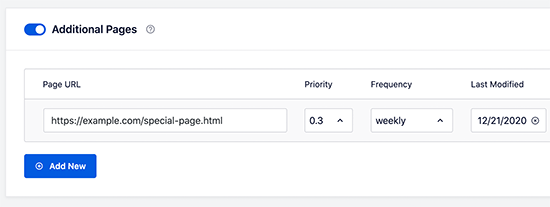
You simply need to add the URL of the page that you want to include and then set a priority where 0.0 is the lowest and 1.0 is the highest. If you are unsure, then we recommend using 0.3.
Next, choose the frequency of updates and the last modified date for the page.
You can click on the ‘Add New’ button if you need to add more pages.
Don’t forget to click on the ‘Save Changes’ button to store your settings.
Excluding Specific Posts and Pages from your XML Sitemap
All in One SEO allows you to exclude any post or page from your XML sitemaps. You can do this by clicking on the ‘Advanced Settings’ section on the All in One SEO » Sitemaps page.

You can also remove a post or page from your XML sitemaps by making it no-index and no-follow. This will block search engines from showing that content in search results.
Simply edit the post or page that you want to exclude and scroll down to the AIOSEO Settings box below the editor.
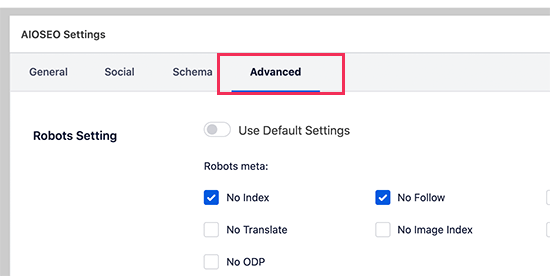
From here, you need to switch to the Advanced tab and check the boxes next to the ‘No Index’ and ‘No Follow’ options.
Creating Additional Sitemaps
All in One SEO allows you to create additional sitemaps, such as a video or news sitemap.
You can create a video sitemap if you regularly embed videos in your blog posts or pages. This will allow search engines to display posts in search and video search results along with a video thumbnail.
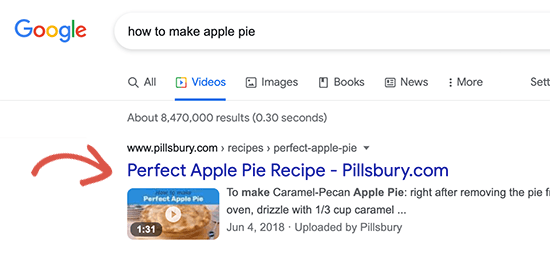
You can also create a News sitemap if you run a news website and want to appear in Google News search results.
Simply go to All in One SEO » Sitemaps and switch to the Video Sitemap or News Sitemap tabs to generate these sitemaps.
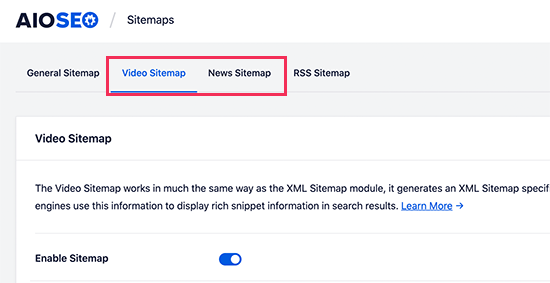
Overall, AIOSEO is the best WordPress plugin because it gives you all the flexibility and powerful features at a very affordable price.
Method 3: Creating an XML Sitemap in WordPress Using Yoast SEO
If you are using Yoast SEO as your WordPress SEO plugin, then it also automatically turns on XML sitemaps for you.
First, you need to install and activate the Yoast SEO plugin. For more details, see our step-by-step guide on how to install a WordPress plugin.
Upon activation, go to the SEO » General page and switch to the ‘Features’ tab. From here, you need to scroll down to the ‘XML Sitemap’ option and make sure that it is turned on.

Next, click on the ‘Save Changes’ button to store your changes.
To verify that Yoast SEO has created an XML sitemap, you can click on the question mark icon next to the ‘XML sitemaps’ option on the page.
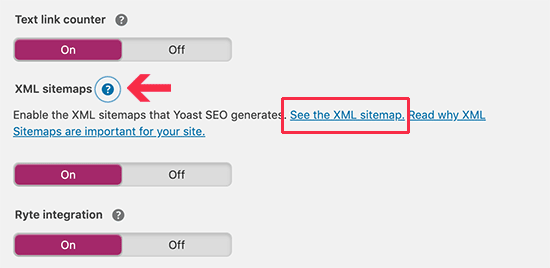
After that, click on the ‘See the XML Sitemap’ link to view your live XML sitemap generated by Yoast SEO.
You can also find your XML sitemap by simply adding sitemap_index.xml at the end of your website address. For example:
https://www.example.com/sitemap_index.xml
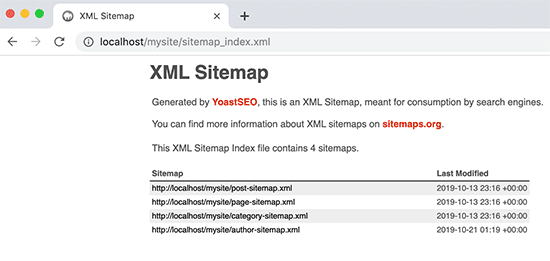
Yoast SEO creates multiple sitemaps for different types of content. By default, it will generate sitemaps for posts, pages, authors, and categories.
Submitting Your XML Sitemap to Search Engines
Search engines are quite smart at finding a sitemap. Whenever you publish new content, a ping is sent to Google and Bing to inform them about changes in your sitemap.
However, we recommend that you submit the sitemap manually to ensure that search engines can find it.
Submitting Your XML Sitemap to Google
Google Search Console is a free tool offered by Google to help website owners monitor and maintain their site’s presence in Google search results.
Adding your sitemap to Google Search Console helps it quickly discover your content, even if your website is brand new.
First, you need to visit the Google Search Console website and sign up for an account.
After that, you will be asked to select a property type. You can choose a domain or a URL prefix. We recommend choosing a URL prefix as it is easier to set up.

Enter your website’s URL and then click on the ‘Continue’ button.
Next, you will be asked to verify ownership of the website. You will see multiple methods to do that. We recommend using the HTML tag method.

Simply copy the code on the screen and then go to the admin area of your WordPress website.
If you are using AIOSEO, then it comes with easy webmaster tools verification. Simply go to All in One SEO » General Settings and then click the ‘Webmaster Tools’ tab. After that, you can enter the code from Google there.

If you are not using AIOSEO, then you can enter the code using the WPCode plugin. This is the safest and easiest way to add code to your WordPress site.
You need to install and activate the WPCode Free Plugin. For more details, see our step-by-step guide on how to install a WordPress plugin.
Upon activation, you need to visit the Code Snippets » Header & Footer page and add the code you copied earlier into the ‘Header’ box.
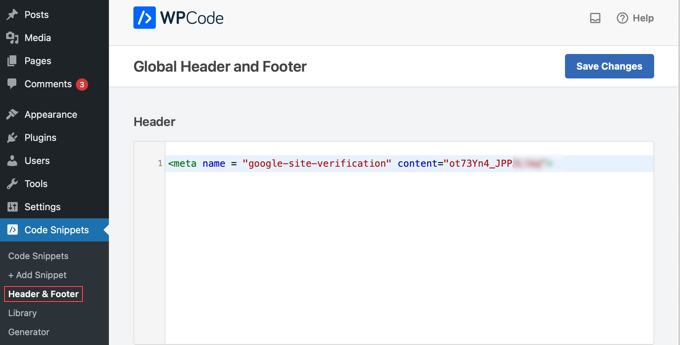
Don’t forget to click on the ‘Save Changes’ button to store your changes.
Now, switch back to the Google Search Console tab and click on the ‘Verify’ button.
Google will check for a verification code on your site and then add it to your Google Search Console account.
Note: If the verification is unsuccessful, then please make sure to clear your cache in WordPress and then try again.
Now that you have added your website, let’s add your XML sitemap as well.
From your account dashboard, you need to click on ‘Sitemaps’ from the left column.

After that, you need to add the last part of your sitemap URL under the ‘Add a new sitemap’ section and click the ‘Submit’ button.
Google will now add your sitemap URL to your Google Search Console.
It will take Google some time to crawl your website. After a while, you will be able to see basic sitemap stats.
This information includes the number of links Google found in your sitemap, how many of them got indexed, the ratio of images to web pages, and more.
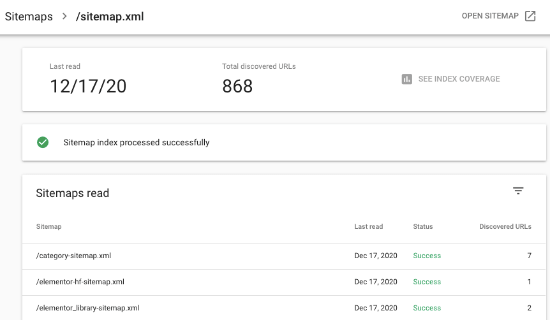
Submitting Your XML Sitemap to Bing
Similar to Google Search Console, Bing also offers Bing Webmaster Tools to help website owners monitor their website in the Bing search engine.
To add your sitemap to Bing, you need to visit the Bing Webmaster Tools website.
Here, you will see two options to add your site. You can either import your site from Google Search Console or add it manually.

If you’ve already added your site to Google Search Console, we suggest importing your site. It saves time as your sitemap will automatically be imported for you.
If you choose to add your site manually, you need to enter your site’s URL and verify the site.
Bing will now ask you to verify the ownership of your website and will show you several methods to do that.
We recommend using the Meta tag method. Simply copy the meta tag line from the page and head over to your WordPress dashboard.
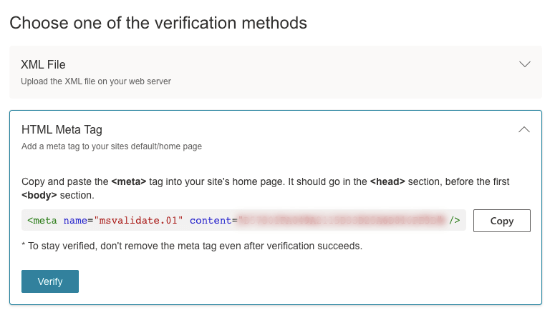
Now, install and activate the WPCode Free Plugin on your website
Upon activation, you need to visit the Code Snippets » Header & Footer page and add the code you copied earlier into the ‘Header’ box.

Don’t forget to click on the ‘Save Changes’ button to store your changes.
Using XML Sitemaps to Grow Your Website
Now that you have submitted the XML sitemap to Google and Bing, let’s take a look at how to utilize it for your website.
First, you need to keep in mind that the XML sitemap does not improve your search rankings. However, it does help search engines find content, adjust crawl rate, and improve your website’s visibility in search engines.
You need to keep an eye on your sitemap stats in Google Search Console. It can show you crawl errors and the pages excluded from search coverage.
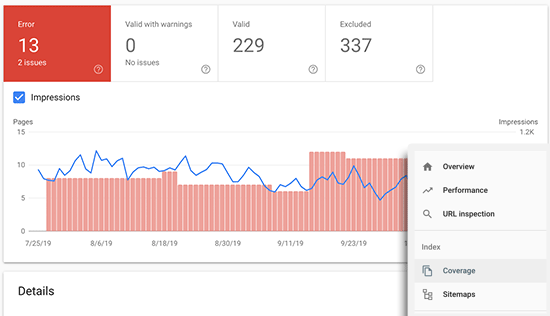
Below the charts, you can click on the different tables.
Here, you can view which actual URLs have been excluded or not indexed by Google.

Normally, Google may decide to skip duplicate content, pages with no content or very little content, and pages excluded by your website’s robots.txt file or meta tags.
However, if you have an unusually high number of excluded pages, then you may want to check your SEO plugin settings to make sure that you are not blocking any content.
For more details, see our complete Google Search Console guide for beginners.
We hope this article helped you learn about XML sitemaps and how to create an XML sitemap for your WordPress site. You may also want to see our guide on how to create a multilingual sitemap in WordPress and our expert picks for the best keyword research tools to write better content.
If you liked this article, then please subscribe to our YouTube Channel for WordPress video tutorials. You can also find us on Twitter and Facebook.





Liv
This article was very helpful. I used the Yoast SEO method. Thank you
WPBeginner Support
You’re welcome, glad our guide could help
Admin
Suzanne
Thanks so much for this it was a massive help! Because I verified and uploaded to Google Console first, I managed to verify and import my website/sitemap to Bing by just connecting my google account (Bing gives you an option for this when you click on sign up) – it was done in less than 30 seconds! I wouldn’t have thought to do Bing, so thank you so much for covering that too!
WPBeginner Support
You’re welcome, glad our guide was helpful
Admin
Tasha
This is honestly the most helpful article I’ve ever seen. I’m not a developer (just new home business owner trying to figure out the rabbit hole that is web dev) and this guided me through all the unknowns I’d had about importance of a sitemap, let alone how it would benefit my site. THANK YOU SO MUCH!
WPBeginner Support
You’re welcome, glad our guide was helpful
Admin
Brittney Gage
I rarely write comments on articles but this was easily one of the most helpful I’ve ever read. Thank you!
WPBeginner Support
Glad our article was helpful
Admin
Harish Nemade
I have my site with only one post published, so is it necessary to submit a sitemap each time when I added a new Article/Post?
And how often should I submit sitemap?
WPBeginner Support
You only need to submit your sitemap once unless there is an error, it will update as you add posts.
Admin
Image Earth Travel
Great article!
Yt’s a pain that the Yoast plugin (as with all plugins) are only offered on the WP’s Business Plan. I’ve been on the Premium Plan and not allowed to install plugins.
WPBeginner Support
Thank you, part of the confusion may be due to our articles being for WordPress.org sites which require hosting instead of the business plan on WordPress.com https://www.wpbeginner.com/beginners-guide/self-hosted-wordpress-org-vs-free-wordpress-com-infograph/
https://www.wpbeginner.com/beginners-guide/self-hosted-wordpress-org-vs-free-wordpress-com-infograph/
Admin
Sarah
I am using the free Yoast SEO plugin but I am not seeing SEO » XML Sitemaps. Any ideas? Thanks
WPBeginner Support
Yoast has updated their interface so you should find it under SEO>General>Features at the moment.
Admin
flyingvan
Thanks for this tutorial, I could activate the sitemap on my website thanks to you.
Mat
WPBeginner Support
You’re welcome, glad our article could be helpful
Admin
Sara
Hello,
Recently I added the sitemap for my website. But, while checked with the tool, it’s showing, no sitemap is added. Why it’s showing like this. I added Yoast SEO plugins.
WPBeginner Support
It could be their caching or if your site has caching that you haven’t cleared it could be part of the issue.
Admin
Jishnu.M
Hi,
I have a problem with sitemap submitting….I am using Yoast SEO when I submit a sitemap to google webmaster it says “couldn’t fetch”…….. but i have successfully submitted sitemap to bing and Yandex without any errors …what to do please help me
WPBeginner Support
For an error like this, you may need to reach out to Yoast’s support to see their recommended troubleshooting for specifically Google not being able to crawl your sitemap.
Admin
Sajol Fuad
I am really happy to get this article about sitemap.
I am using Yoast SEO for sitemaps. Some SEO auditor is saying that I should improve it immediately. But Google search console is showing a green success and assuring that all is ok.
Can you please suggest me what should I do right now?
Thanks for the article..
WPBeginner Support
We’re using the Yoast sitemap without any issues at the moment. If you would prefer what the auditor wants then you could certainly try that if you wanted.
Admin
Charles Harris
I have Yoast SEO but XML sitemaps does not appear on the menu, which indeed looks very different from yours. Any suggestions as to how to find it?
WPBeginner Support
For the current Yoast interface, the Sitemap options are under SEO>General>Features
Admin
Charles Harris
Thanks – got it now.
Joseph
I need some help please,
some pages on my website are not showing on sitemap.xml
I entered it manually to google console, It showed an error that the sitemap format is HTML and that I should change the format
how do I change sitemap format, please?
WPBeginner Support
If you’re using a caching plugin you may want to try to disable it to see if it could be a conflict between Yoast and the caching plugin you’re using.
Admin
Ravi
Hi, awesome tutorial, I did same as your instruction and working fine. But there’s a problem with this, check out the details.
my website is yahoonewsz.com and when I type “www.example.com/sitemap_index.xml”, it works fine but it says page not found when typed “example.com/sitemap_index.xml”.
Why?
WPBeginner Support
You may want to check with your hosting provider that there is not a setting preventing the non www version from redirecting properly
Admin
Arun Dixit
Thanks for your best tutorial!
I recently have a wordpress blog and have created xml sitemap using yoast seo, according to this tutorial in previous month. Yesterday I happend to see my xmlsitemap file at my wp-admin. There are only 5-6 lines which covers my new posts only. What about my old posts? Is there any problem? And how come I know that there is any problem? Because I have more than dozen posts till now.
Kindly let me know.
Arun Dixit
WPBeginner Support
You may want to clear your caching and reach out to Yoast if your sitemap is refusing to update your older posts if you’re not excluding them.
Admin
Darko Loncar
I am using All in One SEO pack Plugin. If I download Yoast’s WordPress SEO plugin should I use both?
WPBeginner Support
No, we would not recommend having multiple SEO plugins active as they can conflict with each other.
Admin
Kirti Goyal
THANKS FOR SHARING THIS INFORMATION!
one thing I want to know is that whether after every single update in pages, posts or change within a post, we need to submit the sitemap???
Looking forward to hearing from you.
WPBeginner Support
You should not need to resubmit your sitemap as long as Google does not run into any errors with your sitemap and with the method from our article it should over time update your sitemap.
Admin
Viraj
Please guide me to make a news sitemap for google news submission.
Luke
I followed these steps but search console is giving me a 404 on the sitemap. I never had such problems submitting sitemaps
Mohammed
In my website, I generated sitemap using this tutorial, however I want to remove one particular non-existent URL from the sitemap as it’s giving 404 error and google adsense is showing crawl error. How do I remove one particualr URL from sitemap and ask google to stop crawling that URL?
Ernest
I see some websites have multiple sitemaps. Is it really necessary?
Dibyajyoti
not really. But some large website for multiple purpose .
greeshma
is sitemaps still relevant in 2018?
WPBeginner Support
Hi Greeshma,
Yes, they are.
Admin
PRANITA DESHPANDE
My site has been verified but can’t find site map near to it .What to do for it ?
cher
I did your step for the sitemap. Awesome! Also, for my robots.txt file I have the following, should I change that first line of sitemap to what yoast says? I am not even sure where I got that old sitemap from but don’t want to mess anything up.
WPBeginner Support
Hi Cher,
Yes, if you are using Yoast SEO, then you should add Yoast SEO sitemap.
Admin
Jude
Hi.
Very helpful information.
I want to ask if it is okay to submit my site to other webmasters like bing, yandex and others.
Thanks so much.
WPBeginner Support
Hi Jude,
Yes, it is OK.
Admin
jude
Thanks so much.
I can’t find my sitemap code in yoast.
I also can’t verify my site on other search console like yandex and bing. (i got cannot verify)
daguah
which social plugin do you use to show the number of shares?
jude
hi. you can use share count or sassy social share
Anshuman Konwar
Thank you Sir, this article is very helpful
William
Is there any one who can help me to change sitemap.xml to some new url like sitmap_page_xml
Leo August
Yoast SEO must have been updated because the check boxes are now sliders – at least on my site. When I enable the stiemap function, then click the link to view the site map, I get a 404 Not Found error. Did I do something wrong?
Rachael
Really helpful article! I have just having trouble when it comes to viewing my site map, it’s coming up with 404 error and I’m not sure why?
John
Hey, there’s nothing like SEO>XML Sitemap in my WP dashboard. Does this feature work on the Premium version of Yoast SEO only? Please help!
WPBeginner Support
Hi John,
It works with free version as well. You will need to enable ‘Advanced settings pages’. Go to SEO » Dashboard page and then click on ‘Features’ tab. Scroll down to Advanced settings page section and click to enable them. Don’t forget to click on the save changes button.
After reload you will see new menu items in under SEO menu. Hope this helps.
Admin
dotun
Hello, I still cant see the xml sitemap on my Wp dashboard.
what can I do?
Rozi
Having the same exact problem. This option does not appear anywhere on my wordpress dashboard. Were you able to get any help with this?
Awais
there is not sitemap option, please help, in fact if i go on “mysite.com/sitemap_index.xml” there i can find the sitemap but settings are not in my dashboard.
Uphoria
Under SEO > General > Features, down by where it says XML Sitemaps, click on the question mark to expand some text.
Click on See the SML sitemap. Then, you can add the URL for your sitemap to the Google Search Console.
Annissa
UPHOARIA, not all heroes wear capes, my friend. Thank you!!! After an hour of trying to figure this out, this was immensely helpful!
Craig Wambusii
after implying the details as clearly elaborated in the blog within a month i saw the changes in my rankings this trick works no hassle. there is a great improvement in my SEO optimization ranking.
Prakash Dayani
Thank you for putting this up nicely, i have one question though for which i need help.
If once i have submitted a sitemap to google and i also have my yoast SEO completely configured, then on adding new content will yoast only update the sitemap or will it automatically submit it to google as well? Or is it that i should submit the sitemap manually to google every time there is new content.
WPBeginner Support
Hi Prakash,
The sitemap generated by Yoast SEO automatically updates itself. You only need to submit your sitemap to Google once. However, if you move your website to a new address, then you will need to resubmit your sitemap.
Admin
Andrea Maria
A site map is a kind of interactive table of contents, in which each listed item links directly to its counterpart sections of the Web site.
Sofia
I have submitted my site map to google
But still not getting organic traffic
What should I do now???
Plzz help me
Desiree
Useful manual.
My sitemap only shows the homepage, and not the 29 other pages of my website. Any ideas on how I can solve this?
Thanks.
nizam
Great post for beginners. Thanks.
I have a question – my site has a subdomain if i create a sitemap for the subdomain will it be part of the whole site (root plus subdomain?)
Ryan
My Yoast Seo XML Sitemaps won’t work with google search console.
“We encountered an error while trying to access your Sitemap. Please ensure your Sitemap follows our guidelines and can be accessed at the location you provided and then resubmit.”
Any ideas?
Geraldine
Ok- your site is my new favorite best friend on the internet!! Thank you sooo much! I’m beginning to feel like a dangerous beginner Thanks for the great tutorials…
Thanks for the great tutorials…
Charmaine
A big thanks, guys! This guide helped me through.
Rebecca
excellent tutorial thank you
thank you
Bhavika Patel
Thank you so much for your instructions.
it was very useful for me.i did all steps and i could put my site map on webmaster tool and also my blog pages only because of your helpful article.
Mad
Error while submitting sitemap generated by yoast: sitemap_index.xml
Sitemap is HTML
Your Sitemap appears to be an HTML page. Please use a supported sitemap format instead.
Sola Mathew
Wow.
I just added my site map to Google.
Thanks so much.
Bruna
Hello, thank you for the detailed article, finally I understood how it works!
I think I did all correctly, but when I submitted the sitemap I received an error from Webmaster Tool, saying: “We encountered an error while trying to access your Sitemap. Please ensure your Sitemap follows our guidelines and can be accessed at the location you provided and then resubmit.”
Certainly the location is correct, and their guidelines don’t give me a clue of what is happening
Any idea? Thank you in advance.
Bruna
WPBeginner Support
Hi Bruna,
Try adding your website without www prefix. Google treats www and non-www as two separate domains.
Admin
Irfan
HI to wpbeginner team. 1st of all thank you for your excellent work and helping beginner in such a great way. I am using All in one Seo and came to know you use for your sites Yoast Seo. Can you guide me how do I shift to Yoast without messing up my sure??
Thank you in advance
WPBeginner Support
Hi Irfan,
Yoast SEO actually has a tool inside the plugin that will help you migrate.
Ammad Ali
i am trying to create sitemap and i created a lot of sitemap using different plugins but when i click on sitemap it says nothing found.
how to solve this issue
Matt
Under sitemaps, for webpages, it’s saying 104 were submitted, but only 14 were indexed. Yoast SEO gave me 3 sitemaps which I added.
Zinah
Thank you.it helped me to do my XML sitemap
Riwan nair
How xml sitemap will show to user?
Võ Điền
Great! Thank you for this tutorial!
Akin
I’m having lots of duplicate content on my website. I’m thinking that i didn’t fix the Yoasts SEO very well. How can i remove them?
Thanks in advance
WPBeginner Support
Hey Akin,
Please see our guide on how to install and setup Yoast SEO plugin. It will help you properly setup Yoast SEO plugin.
Admin